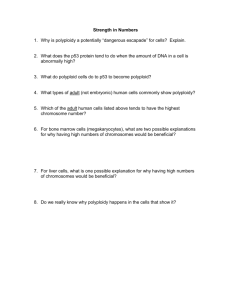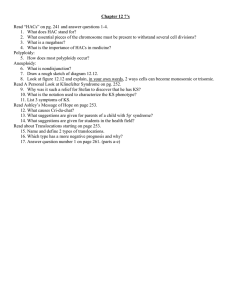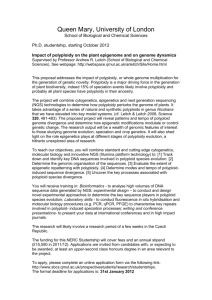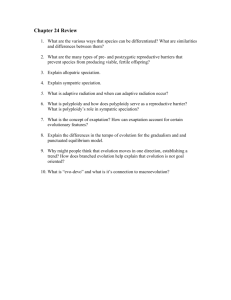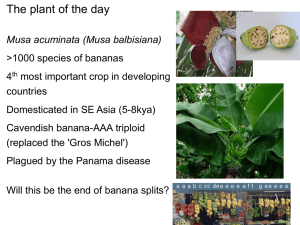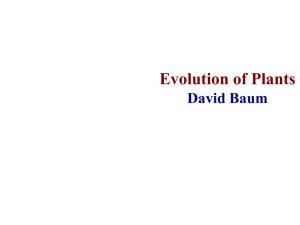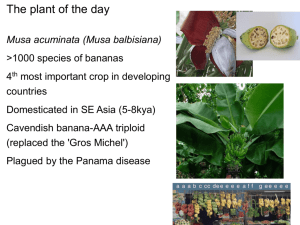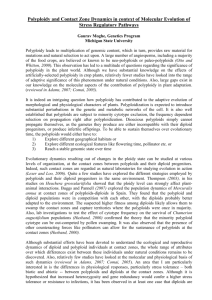Overview of polyploidy
advertisement
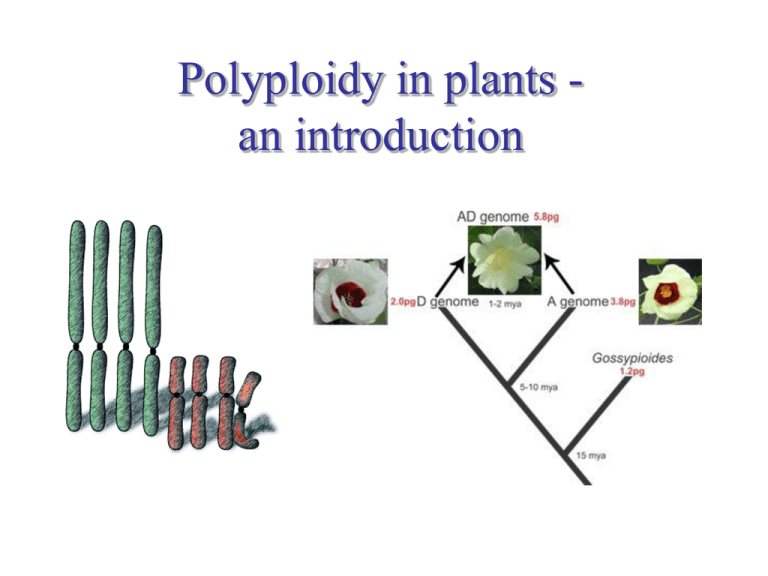
Polyploidy in plants an introduction Polyploidy in plants an introduction My credentials? selection of Washington University for Ph.D. work; Walter Lewis and International Conference on Polyploidy: Biological Relevance (May, 1979) Polyploidy in plants an introduction selected to work with Barbara Schaal & Peter Raven - expert on polyploid evolution, especially in California taxa Polyploidy in plants an introduction lab mates with Jeff Doyle - Ph.D. on polyploid Claytonia (spring beauty) at Indiana with Charlie Heiser but doing post-doc with Walter Lewis and Roger Beachy on polyploidy in Glycine (soybean) Polyploidy in plants an introduction Jeff Doyle was the Ph.D. advisor of Eve Emshwiller at Cornell Polyploidy in plants an introduction while at Washington University, Jeff Palmer (then a postdoc at Stanford, now at Indiana) gave a talk on molecular phylogenetics presented DNA evidence to solve portions of U’s triangle on Brassica polyploid evolution provided Washington U with probes to do molecular phylogenetic work Polyploidy in plants an introduction I went onto Davis for a postdoc with Les Gottlieb to look at DNA based relationships of diploids and polyploids in Clarkia for various reasons, other issues in Clarkia became more important Cody Williams is now finishing the original story first begun in Davis (and earlier by Raven) C. purpurea n=26 Polyploidy in plants an introduction in 1984, three people vied for the first two plant molecular systematics positions in the world at Madison and Ithaca - myself, Jeff Doyle, and Jonathan Wendel Polyploidy in plants an introduction Jonathan Wendel now at Ames switched over into more evolutionary genomics questions — e.g. Gossypium polyploidy Polyploidy in plants an introduction Tom Osborn and Keming Song, UW Agronomy, sat in on my Bot 563 to learn how to phylogenetically analyze their Brassica data Polyploidy in plants an introduction shortly thereafter, David Spooner “rotated” in my lab for one year to learn how to do DNA phylogenetic analysis on Solanum sect. Petota he was kind enough to include me as author on two papers dealing with polyploid evolution in this group — more on that story later Polyploidy in plants an introduction David Baum joined my lab in 1990 as postdoc to do phylogenetic analysis of Epilobium and relatives to address chromosome number (and polyploid) evolution Polyploidy in plants an introduction Chris Pires, my graduate student and now at U Missouri, does postdocs with Soltis and Soltis on Tragopogon and later with Osborn on Brassica Polyploidy - a history Polyploids - plants containing more than the normal number (two) sets of chromosomes Aneuploids - plants containing fewer or more chromosomes from the basic (x), or multiples of x, number of chromosomes if x = 6, then a diploid would have 2n = 12 chromosomes Polyploids would have 2x = 12 or 2n = 24, for example — tetraploid (4 sets) Aneuploids would have deviated from x = 6, to have 2n = 10, 2n = 8, or 2n = 14, for example Polyploidy - a history Hugo DeVries - published “Mutation Theory” in 1901 polyploid mutants in Oenothera played an important role in his work Oenothera lamarckiana on book face Polyploidy - a history selected this species in 1886 because appeared to be good candidate for “saltational” mutants did large-scale greenhouse experiments to find mutants Polyploidy - a history of many, the ‘gigas’ mutant is important here as it turned out to be a spontaneously derived tetraploid (2n=14 is typical for Oenothera) Polyploidy - a history DeVries and Gates had long argument over the nature of ‘gigas’ in terms of impact on everything from increase cell size to more robust plant vigor Polyploidy - a history Eduard Strasburger (1844-1912) founder of modern cytology - first coins the term ‘polyploid’ Polyploidy - a history Winkler (1916) - earliest study of polyploidy by forming chimaeras between different species of Solanum. Tissue of the anther wall showing high-polyploid cells side by side with diploid cells. from Briggs & Walters, 1997 Polyploidy - a history O. Winge (1917) - first classic paper on polyploid distinguishes two types of polyploids autopolyploids - derived within a single individual allopolyploids - polyploidy succeeding hybridization Kihara and Ono (1926) actually coin the terms ‘autopolyploidy’ and ‘allopolyploidy’ Polyploidy - a history autopolyploidy allopolyploidy Polyploidy - a history Clausen & Goodsend (1925) form hexaploid tobacco Nicotiana glutinosa 2n = 24 diploid - 1x N. tabacum X 2n = 48 tetraploid - 2x = 2n = 72 hexaploid - 3x Polyploidy - a history Karpechenko (1925) derives radish X cabbage polyploid hybrid (Raphanobrassica) Georgi Karpechenko (1899-1941) Polyploidy - a history A viable hybrid progeny individual was produced from seed. However, this hybrid was functionally sterile because the 9 chromosomes from the cabbage parent were different enough from the radish chromosomes that pairs did not synapse and segregate normally. Eventually, one part of the hybrid plant produced some seeds. On planting, these seeds produced fertile individuals with 36 chromosomes. They had apparently been derived from spontaneous, accidental chromosome doubling to 2n1+2n2 in one region of the sterile hybrid, presumably in tissue that eventually became germinal and underwent meiosis. Unfortunately for Karpechenko, his allopolyploid had the roots of a cabbage and the leaves of a radish Karpechenko in the original ‘cabbage patch’ Polyploidy - formation doubled chromosomes in somatic cells (mitosis) or unreduced gametes (meiosis) occur infrequently but do occur experimentally, this can be done by the addition of the alkaloid colchicine Polyploidy - formation Colchicum autumnale meadow saffron from Briggs & Walters, 1997 Polyploidy - reproductive isolation Once formed, allopolyploids are reproductively isolated from other species of other ploidy levels Polyploidy - reproductive isolation Once formed, allopolyploids are reproductively isolated from other species of other ploidy levels from Briggs & Walters, 1997 Meiosis in a triploid hybrid. Note mixtures of bivalents (black) and univalents (white) at metaphase I of meiosis. Polyploidy - types autopolyploidy allopolyploidy Polyploidy - types Ramsey & Schemske 2002 Polyploids are defined either by mode of origin (MO) or by cytological criteria (CC) MO autopolyploids arise within single populations or between ecotypes of a single species, whereas allopolyploids are derived from interspecific hybrids Autopolyploids have only homologous chromosomes; allopolyploids have two or more sets of homeologous chromosomes CC allopolyploids are expected to display bivalent pairing, lack of allosyndesis and disomic inheritance, while CC autopolyploids will exhibit multivalent configurations, nonpreferential pairing at metaphase, and multisomic inheritance Polyploidy - types Ramsey & Schemske 2002 The expected does not always (usually) occur 80% of recent allopolyploids show some amount of multivalents Polyploidy - types Therefore, strict allopolyploid definition would exclude the classical Primula kewensis Chromosome pairing at meiotic metaphase in (a) Primula verticillata, (b) P. verticillata X floribunda, and (c) the hybrid polyploid P. kewensis with some multivalents from Stebbins, 1971 Polyploidy - types Ramsey & Schemske 2002 The expected does not always (usually) occur 80% of recent allopolyploids show some amount of multivalents All recent autopolyploids show no evidence of preferential pairing or disomic inheritance . . but later generation autopolyploids can show genic effects that lead to “diplodized” autopolyploids Polyploidy - types Stebbins 1971 - argued for a continuum I. II. Autopolyploids 1. Strict autopolyploid AAAA 2. Interracial autopolyploid AAAA Amphidiploids 1. Segmental allopolyploid AsAsAtAt 2. Genomic allopolyploid AABB 3. Autoallopolyploid AAAABB Polyploidy - how common? rare in animals rare in fungi (but its an animal) common in plants gymnosperms - rare non-seed vascular plants - common flowering plants - common actual species counts difficult to get Polyploidy - how common? actual species counts difficult to get - why? what constitutes a “species”? tropical flora (upwards of 1/3 - 1/2 of all species) little sampled — extrapolation required incorrect published chromosome numbers Chromosomes in Myosotis checked by Merxmuller & Grau Myosotis stricta from Briggs & Walters, 1997 Polyploidy - how common? Estimates in flowering plants (& author’s rationale) Stebbins (1971) 30-35% (obvious polyploid series) Grant (1971) 47% ( > x = 13 ) 43% dicots & 58% monocots Goldblatt (1980) 70% (monocots) Lewis (1980) 70-80% (dicots) ( n = 11, 10 (9) ) Polyploidy - high numbers from Grant, 1981 Ophioglossum (adder’s-tongue fern) 2n = 1440 (96 ploid) in O. reticulatum Polyploidy - high numbers Sedum suaveolens - 2n = ca. 640 (80 ploid) dicot Voanioala gerardii - 2n = ca. 596 (50 ploid) monocot Polyploidy - life form correlation Stebbins, 1971 Chromosomal evolution in higher plants Polyploidy - latitude correlation Frequency of polyploids (black %) in the floras of various territories in the Northern Hemisphere (from Love and Love, 1974) from Briggs & Walters, 1997 Polyploidy - latitude correlation Spitsbergen from Grant, 1981 Polyploidy - latitude correlation Chamerion angustifolium - fireweed (Onagraceae) Both diploid and tetraploid individuals are found in North America, with diploids generally occurring at higher altitudes and more northerly latitudes. An overlap zone where both diploids and tetraploid fireweed co-occur is located at intermediate altitudes in the Canadian Rockies and along the southern border of the boreal forest. http://www.uoguelph.ca/botany/research/evollab/rockies.htm Polyploidy - size correlation Stebbins, 1971 Chromosomal evolution in higher plants Polyploidy - size correlation Ramsey & Schemske, 2002 Polyploidy - size correlation Stebbins 1971, Fig. 6.11 Sequoia sempervirens (2n=66) - relictual hexaploid; fossils appear to be diploid — no close relatives. Sequoiadendron giganteum in another genus is diploid. Polyploidy - range extension Stebbins 1971, Fig. 6.5 Map of western North America and distributions of diploid and tetraploid Zauschneria (= Epilobium) Polyploidy - range extension C. purpurea n=26 C. tenella n=17 reversed! C. williamsonii n=9 Limits of distributions of diploids, tetraploids, and hexaploids in Clarkia sect. Godetia Stebbins 1971, Fig. 6.10 Polyploidy - apomixis Sexual and apomictic species in Sorbus from Briggs & Walters, 1997 Polyploidy - Systematic Tests Asplenium - flavonoids A. platyneuron A. rhizophyllum A. montanum A. X kentuckiense (trigenomic polyploid) from Briggs & Walters, 1997 Polyploidy - Systematic Tests Bommeria hispida - copper fern Haufler, 1985 - Isozymes 2n=60 to 90 species all show isozyme loci number typical of diploids Polyploidy - Systematic Tests Equisetum 2n =216 Psilotum 2n =104-416 Polyploidy - Systematic Tests Tribe Astereae n = 2 to n = 9, with n = 4, 5 very common Raven et al. (1960) — all diploid numbers with aneuploid reduction Turner et al. (1961) — n = 9 are allopolyploids from diploid n = 4 and n = 5 Gottlieb (1971) showed that all have the same number of isozymes and thus all diploids in Machaeranthera (3 species with n = 4, 5, 9) and Aster (2 species with n = 5, 9) Machaeranthera coloradensis Polyploidy - Systematic Tests Epilobium n = 9, 10, 12, 13, 15, 18 Stebbins (1971 & Raven) — original basic number is x = 6 or 9, x = 18 is of secondary polyploid origin Polyploidy - Systematic Tests Epilobium n = 9, 10, 12, 13, 15, 18 Baum, Sytsma, Hoch (1994) — DNA sequence evidence does not support the Stebbins’ model most parsimonious Polyploidy - Systematic Tests Epilobium n = 9, 10, 12, 13, 15, 18 Baum, Sytsma, Hoch (1994) — DNA sequence evidence does not support the Stebbins’ model but possible Polyploidy - Systematic Tests Genomic in situ hybridization (GISH) or Flourescent in situ hybrization (FISH) Tragopogon - goat’s beard Polyploidy - Systematic Tests C. arenosa A. suecica - naturally occurring allopolyploid in Europe http://comailab.genomecenter.ucdavis.edu/polyploidy.htm Polyploidy - Systematic Tests http://comailab.genomecenter.ucdavi s.edu/polyploidy.htm Multiple copies of the red and green genomes are visible in this picture of tapetum cells from Arabidopsis suecica allopolyploids Image Credits Arabidopsis suecica http://linnaeus.nrm.se/flora/di/brassica/arabs/arabsue3.jpg Bommeria hispida http://botany.cs.tamu.edu/FLORA/swts/pter002.jpg Cardaminopsis arenosa http://www.ruhr-uni-bochum.de/boga/html/Cardaminopsis_arenosa_Foto.html Clarkia purpurea winecup clarkia http://www.kenbowles.net/SDWildflowers/FamilyIndexes/Onagraceae/OnagraceaeKey.htm Clarkia williamsonii Fort Miller clarkia http://www.timetotrack.com/jay/mtns/clarkw.htm Clarkia tenella http://www.chilebosque.cl/herb/ctene01.jpg Colchicum © Peter v. Sengbusch - b-online@botanik.uni-hamburg.de Epilobium cana http://www.coepark.org/wildflowers/red/epilobium-canum.jpg Epilobium polyploid http://www.uoguelph.ca/botany/research/evollab/rockies.htm Machaeranthera coloradensis tansy aster http://www.conps.org Myosotis stricta http://www.atlas-roslin.pl/foto/ji/ji-20040501265.jpg Image Credits Nasturtium microphylla http://www.plant-identification.co.uk/skye/cruciferae/nasturtium-microphyllum.htm Ophioglossum reticulatum http://cookislands.bishopmuseum.org/ http://moorea.berkeley.edu/flora/fernphotos/ophioglossum_retic1.jpg Primula kewensis http://homepage3.nifty.com/wako3/saibaisousyun/Primulakewensis/Primulakewensis.htm Primula verticillata (Abyssinian primrose) http://www.botanic.jp/plants-ha/priver.htm Sorbus aucuparia http://www.kuleuven-kortrijk.be/bioweb/ Sorbus torminalis http://www.saxifraga.de/europa/gesamtartenliste.html Spitsbergen flora poppy http://upload.wikimedia.org/wikipedia/commons/thumb/4/49/Poppy3.jpg/300px-Poppy3.jpg Spitsbergen flora Silene http://www.digitalnature.org/flora/silene%20furcata%20kl.jpg
